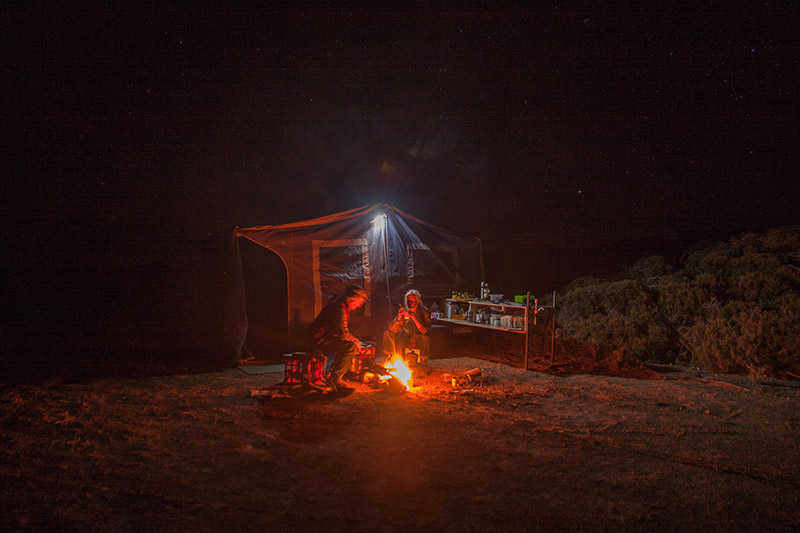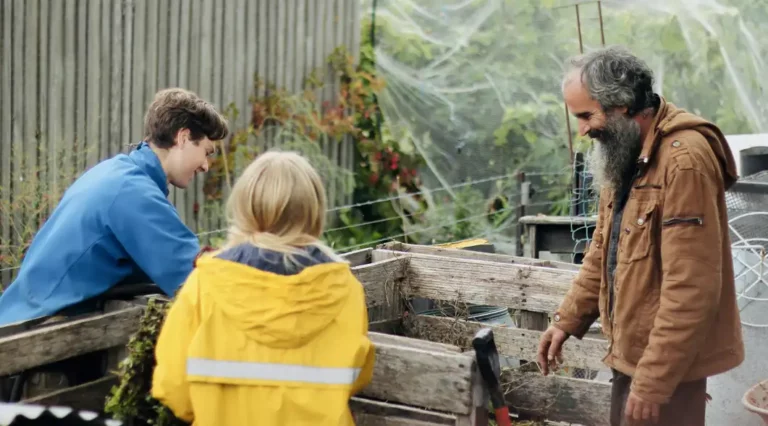Sunday 21st morning we were back over Horricks Pass down to Highway One, past the Sundrop hydroponic “farm” and into Port Augusta. There was dust in the air with a strong northerly and a temperature climbing into the 20s. With the aid of Google we did some shopping (mostly hardware including filling our small gas bottle just in case we couldn’t cook on wood everywhere we went) and foraged freshly fallen huge black olives on the footpath under trees still laden.

Su foraging fallen olives
Our destination for the day was out beyond the arid zone pastoral chenopod shrubs to Mt Wudinna in the green wheat sheep belt of western Eyre Peninsula. We had left Port Augusta without refuelling The Blue with 98 octane petrol so decided to check out Iron Knob, the small settlement attached to the iron ore mines than have sustained the steel mills at Whyalla for more than a century. Google suggested three sources of fuel but that must have been information from before Google existed. There was no petrol outlet we could find.

A petrol outlet in Iron Knob
The mine is still massive but it appears very few of the workers live locally. Given the bizarre fly-in fly-out mine commuters of northern Australia, the 100km commute from Pt Augusta or 50 km from Whyalla seems local. We eventually got fuel in Kimba where we photographed another great example of silo art and sent a pic of Su next to the sign “Kimba welcomes you” to Su’s older son Kimon in Brussels whose nickname is Kimba.
Mt Wudinna is a pink granite monolith amongst the grain fields north of the small town named after it. How extraordinary that this second largest monolith after Uluru is almost unknown. The sign at the empty car park said no camping so in the dusk gloom we followed a track into the mallee a little further on to find a camp next to a very large concrete water tank with a roof just above ground level. In the morning we discovered we were still within the reserve and that the tank was the collection point for two granite lined channels that received water from stone and concrete “gutters” build around the part of the monolith.
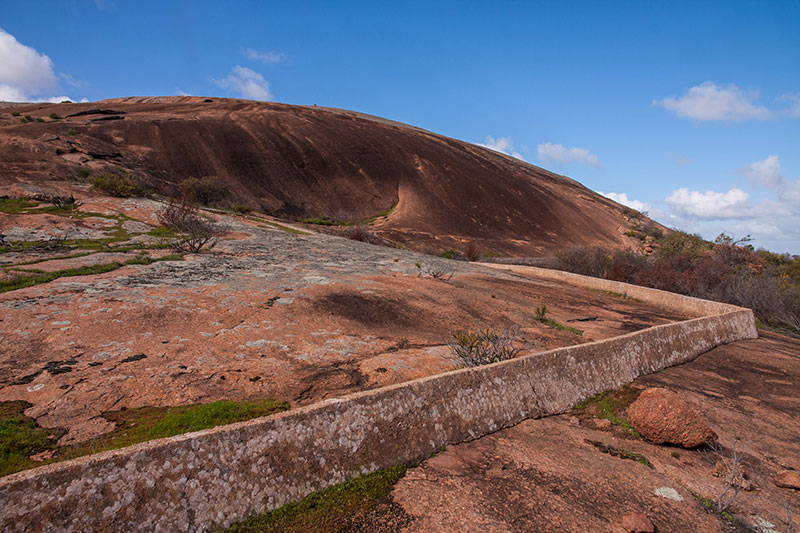
Gutters for collecting rock runoff to farm water supply system constructed in the 1920s
Bill Mollison included a photo and description of such collection systems in Permaculture Two but this was on a much larger scale, apparently built by the government about 100 years ago to supply water to surrounding farms. With a security fence, PV panels and active pump, it was clearly still in use.
As we approached the monolith Su asked for “permission” to climb, reflecting on how such an extraordinary place must have been special and therefore sacred to indigenous people. The info in the carpark and interpretive trail was fairly old school, perhaps from the 1980s, focused on geology and plants but bare mention of indigenous interpretation. While the geological explanations for the amazing rock forms including Tafoni, A-tents, Rillens and Gnammas were interesting, but we could only imagine the complexity of creation stories that would have explained such a sculpture park and whether indigenous people did their own cultural modifications of the rock to enhance water harvesting.
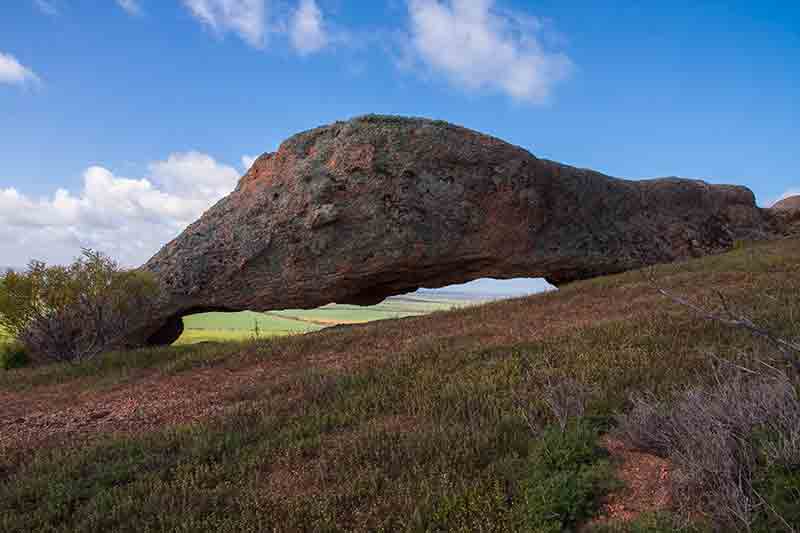
An A-tent giving all the appearance of a construction
Next day David returned to explore further and take photos with low angle morning light while Su cleaned out some of the debris in the stone channels.
Following a network of dirt roads back to the highway we planned a detour to the coast at Streaky Bay. The tourist, holiday and oyster farming development that had happened since our 1999 return trip along this coast was notable. The holiday houses at the hamlet of Smoky Bay seemed mostly new but the presence of a new self-storage facility had us thinking about changing habits of holidaymakers.
A brief stop in Ceduna allowed us to purchase and change over the battery in The Blue (for a price not much more than offered online). It seemed flattening the battery was the last straw for the old battery that we had been working hard keeping laptop charged.
A sheltered camp spot just off the highway had plenty of wood and it was possible to hear the distant roar of the southern ocean 3 km to the south in the long intervals between the approaching and receding 36 and 46 wheeler road trains heading east and west with their cargoes to keep the time bomb of the Australian economy ticking.
We had our usual late departure after a breakfast of the last of our gifted and foraged fruit, commercial yoghurt, toast of the delicious Melrose rye sourdough with organic butter (purchased at the farmers market in Newcastle) and marmalade Su made on the campfire at Fitzgerald Bay with Lyall’s tangelos – and of course acacia “coffee” with a dash of the Paris Ck biodynamic milk.
A detour to Fowler Bay had us spotting an Australian Sea Lion being dived bombed by seagulls but no whales, although there were about 30 around according to the tour info. The road though Coorabbie to Nundroo on the highway was severely corrugated, reminding us why long trips on outback roads would probably destroy The Blue.
Along the road we saw 500 acres for sale of what looked like the more marginal paddocks with rusting harvesting machinery – symbols of past optimism. At Nundroo we left behind the last of the paddocks of crops and “improved” pastures which were still being grown despite the drying climate.
Each stop, whether overnight or just for lunch seemed to bring us closer to the earth – literally as long as we could avoid the rubbish which Su found so painful. David reminded her how it was better here in Oz than many countries we had travelled through.
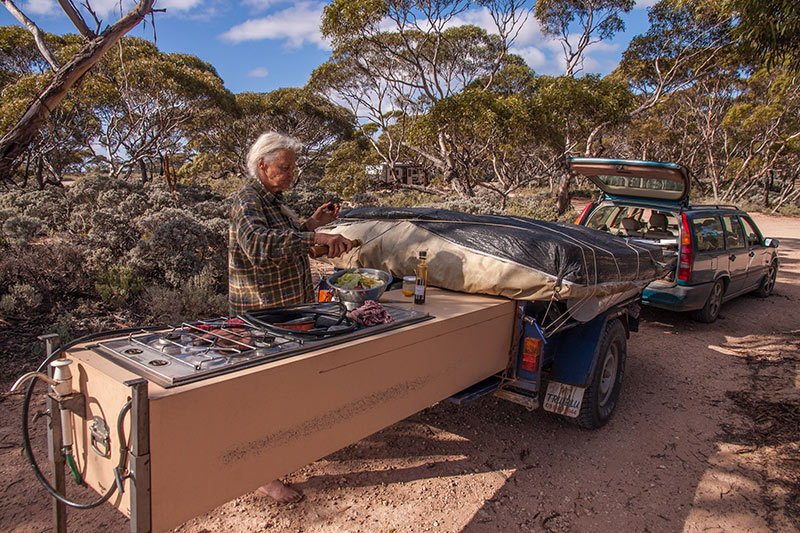
Su preparing lunch amongst the saltbush at an Eyre Highway roadside stop
The next detour was more mainstream – at the head of the Bight we paid our entry fee to the marine park whale interpretive centre and viewing platform from which we saw dozens of southern right whales just beyond the swell breaking on the limestone cliffs. Certainly an exhilarating experience with a sense of hope for the recovery of the population of these great creatures. The massive slaughter of the 19 th century provided lamp light for the rising middleclass after tallow supplies were no longer able to meet the demand, before coal gas and kerosene from oil took over the task of turning night into day on a massive scale (even before we began with electricity). Of course the harvesting of whales didn’t end in the 19 th century – David remembers being on holiday in Albany collecting Sperm Whale teeth from the water at the Cheynes Beach whaling station in 1965.
A few logistical issues were shaping our journey west. A planned business meeting with staff by Zoom required internet. Su’s phone account with Aldi has coverage for 98% of the Australian population but that doesn’t include anywhere across the Nullarbor, so we were planning to be in Norseman to get reception for that meeting.
Travelling at a speed of 90kph and not travelling at night to avoid kangaroos, combined with a desire to experience our camp spots and the journey, meant getting more than 500km a day was pushing it. And all these detours and photo stops were certainly slowing our westward journey.
The next issue was the looming encounter with WA border quarantine. While other mainland states are relatively laid back, entering WA is like going to a foreign country, which some would say it is.
Su was planning to not dump any of our grown, bartered, bought, gifted and foraged fresh food by making sure we had either consumed or cooked it before the border. A big cook up at the bush camp west of Ceduna, two sumptuous salads and pre-prepared meals the next two days had us ready to face the border check.
On the Nullarbor proper at our final SA camp we found shelter from the westerly breeze behind some spreading eucalypts (probably E. yalatensis) pretending to be shrubs. We avoided any wood harvesting other than kindling and finally made efficient use of our limited stock of firewood (for cooking and winter warmth) that we had been carrying since the Southern Flinders.
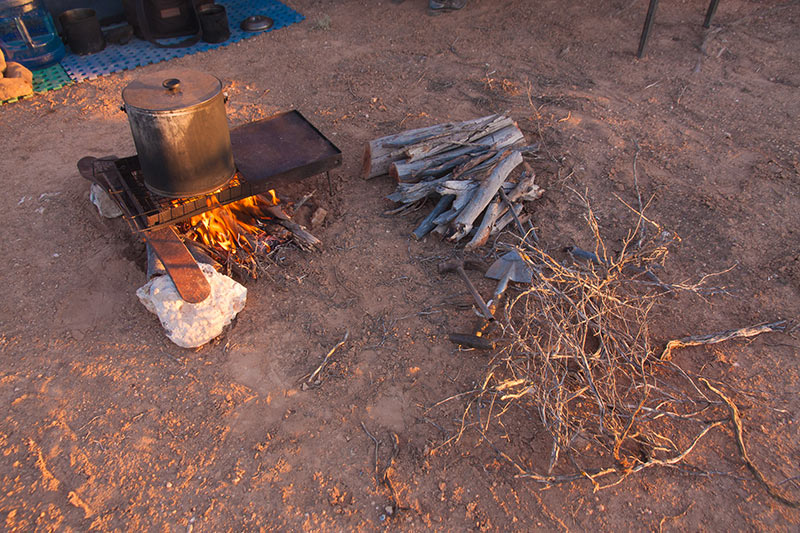
Our fire of Flinders Ranges Blue Gum (E. leucoxylon) and saltbush kindling
In the morning we woke to a thick fog and the camper windows dripping with water on the north side that reminded David of stories of mesh being used to harvest limited water from fog in the rainless Atacama Desert of northern Chile. Here it seemed strange that the fog inception came from the desert to our north rather than the sea to the south.
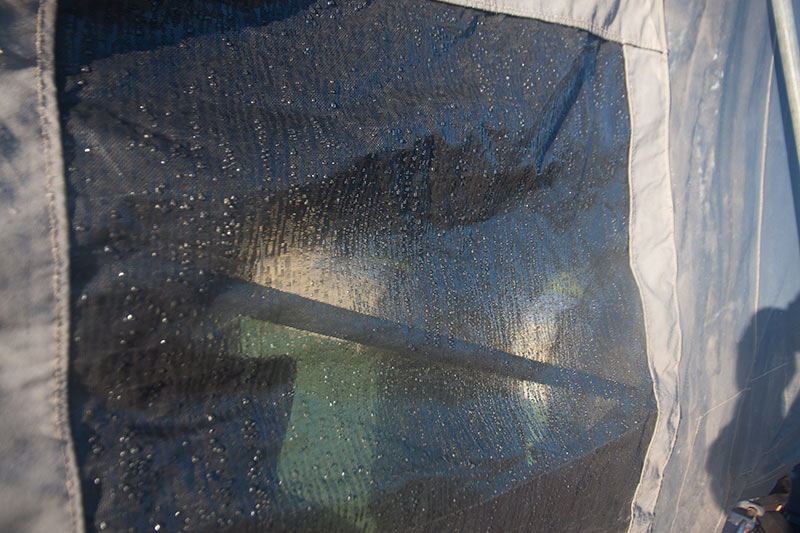
Fog inception on the camper insect screens
After more stops at two of the viewing points where the highway is only a kilometre from the cliffs of the Great Australian Bight we arrived at the Border Village about midday. After waiting in the queue for some time, the quarantine lady was quite apologetic and perfunctory in going through our camper. However in her focus on all our supplies in the camper, Su had forgotten that she was going to salt the olives slowing drying in the back of the station wagon. On declaration the quarantine lady was at first unsure, then certain, they had to go in the bin and then agreed to Su salting them and showing her before we left the border station. What a nice experience of public servants doing their job diligently while not being unnecessarily draconian.
<< Previous Chapter — — — Next Chapter >>
